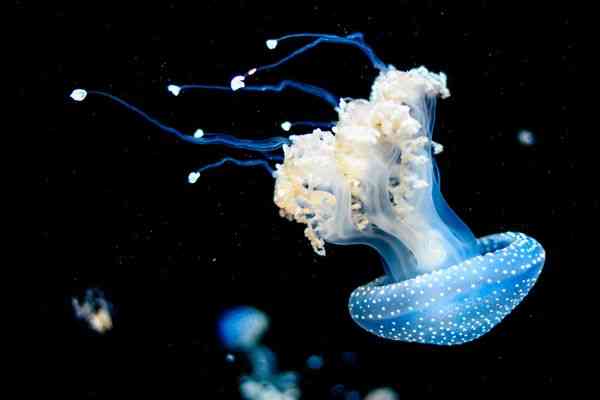You may have noticed fireflies blinking green light at night and may have wondered how do they produce light. Not only fireflies but also many other organisms, especially marine organisms such as fish, algae, bacteria, and viruses, can produce light. It is the magic of bioluminescence. Bioluminescent organisms can be found on land as well as in seawater. They are present in almost every part of the sea, from coast to the open ocean, from the seafloor to the surface.
The chemistry behind bioluminescence
Bioluminescence is the result of a chemical process named “chemiluminescence.” The method of light production by a chemical reaction is called chemiluminescence. Two chemicals react with each other yielding a high energy compound that is unstable. The unstable high energy compound releases energy to its surroundings to reach a stable state. The energy is released as light. When the light is produced by a living organism, it is called bioluminescence. In other words, bioluminescence is chemiluminescence inside a living organism.
Bioluminescence requires two chemicals to react with each other. One is Luciferin, an organic compound, and the other chemical is Luciferase which is an enzyme. Enzymes are chemical compounds also known as bio-catalysts, which interact with other chemical compounds known as substrates.

Luciferin is oxidized in an enzymatic reaction. Luciferase enzyme catalyzes the reaction. The reaction yields oxyluciferin and light is produced. Even though most bioluminescent organisms produce light this way, the presence of luciferase enzyme is not necessary to produce light. Some reactions involve the use of photoproteins to create light.
Photoproteins are a special variant of luciferase. They are proteins that can produce light when combined with an oxidizing agent. Calcium-activated photoproteins undergo a covalent reaction and associates with oxygen, luciferin, and Ca2+ ion. This reaction emits light.
This process is astronomically efficient. Virtually, 100 percent of the chemical energy converts to light. The light produced by bioluminescence is called “cold light” as the conversion of chemical energy is near 100 percent efficient, and very little heat is produced in the process.
Most organisms synthesize luciferin in their body while others acquire it from diet or via symbiotic relationship. The color of produced light varies depending on the type of luciferin an organism carries. Some luciferins can even create multiple colors of light. Squids contain a luciferin named Coelenterazine which can produce blue, turquoise and purple light when oxidized. Fireflies contain firefly luciferin which produces green and orange light upon oxidation.

Role of Bioluminescence:
Bioluminescence plays a significant role in the deep-sea ecosystem. Most of the deep-sea organisms can produce light that serves various purposes and helps them survive in a dark environment where sunlight cannot reach. Some animals use bioluminescence as a means to communicate with each other. Male fireflies attract female fireflies for mating by lighting up. Their pattern of flashing helps female fireflies identify their interest in mating.
Some organisms use bioluminescence as a defense mechanism. Some squids eject a bioluminescent mucus, which confuses predators letting the squids escape. Brittle stars detach glowing arm while being hunted which distracts the predator. The predator follows the glowing arm allowing the animal to escape.
Bioluminescence is also used as a lure by many animals to search for prey. Loosejaws emits red light while most fishes can only see blue light. When loosejaws light up, they can see their surrounding environment while their prey cannot see them. Also, some bacteria use bioluminescence as a way to utilize energy in their metabolic pathways.
While bioluminescence is mainly a natural phenomenon, it is now being utilized in various artistic and scientific purposes. Artists utilize bioluminescence to create art using a photographic technique known as light painting.

Since the involvement of ATP is directly related to light emission, researchers studied the chemical reaction in bioluminescence to understand the energy conversion in cells. Scientists can also use bioluminescence as a tool to build a deeper understanding of deep-sea life and ecosystem. Green fluorescent protein (GFP) is used as a reporter gene by biological researchers. The principles of chemiluminescence are also utilized in forensic sciences.
Researchers are experimenting and trying to introduce bioluminescence in trees and crops. This can be used for beautification purposes as well as reducing dependence on electricity for light.
Sources:
- Chemiluminescence. Retrieved from https://www.sciencedirect.com/topics/materials-science/chemiluminescence on 04/27/2020
- Chemiluminescence. Retrieved from https://chem.libretexts.org/Bookshelves/Physical_and_Theoretical_Chemistry_Textbook_Maps/Supplemental_Modules_(Physical_and_Theoretical_Chemistry)/Spectroscopy/Electronic_Spectroscopy/Radiative_Decay/Chemiluminescence on 04/27/2020
- Bioluminescence. Retrieved from https://www.nationalgeographic.org/encyclopedia/bioluminescence/ 04/27/2020
- Bioluminescence. Retrieved from https://ocean.si.edu/ocean-life/fish/bioluminescence on 04/27/2020
- Bioluminescence. Retrieved from https://www.britannica.com/science/bioluminescence on 04/27/2020
Subscribe to our newsletter to stay updated


